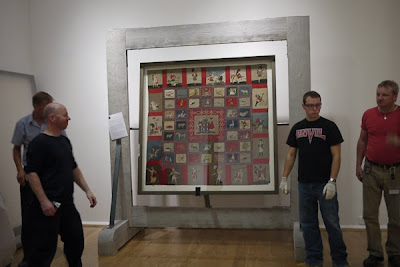
This Chinese umbrella is a commemorative treasure associated with the activities of Christian missionary workers in China in the early 20th century. The strong indigenous style and choice of colours, especially the large Chinese characters embroidered in appliqué fabric round the top, might at first give the impression that this was a traditional handcrafted item for use in a religious ritual. The Chinese writing found on the colourful ribbons, however, gives us hints to the origin and purpose of this umbrella. It says on one the long ribbons, ‘西历一千九百零四年大英伦敦会会首包维廉老夫子老大人德政’ which translates as ‘the year 1904, the Chief of the London Society Bao Wei Lin as a great master and a great man who demonstrates his benevolent rule'.

 On another ribbon, it is written ‘西历一千九百零四年三月初十日、光绪三十年正念四日,黄冈、陂、安县各教士、执士暨教友、学友等仝敬’ meaning ‘regards from the church missionaries, ministers, members and fellows from the District church in Huang Gang, Huang Pi and Huang An on the 10th of March, 1904 (same as the 4th day of the first month in the 30th year of the reign of Emperor Guangxu). The writing on the other long ribbons has meanings about receiving blessings from the appointed church ministers in the three districts while each of the small ribbons has the name of district church members. So we can deduce that the umbrella is a gift from the London Missionary Society’s district church in Huang Gang, Huang Pi, and Huang An in Wuhan to Bao Wei Lian (William) the society senior officer who visited China on 10 March 1904.
On another ribbon, it is written ‘西历一千九百零四年三月初十日、光绪三十年正念四日,黄冈、陂、安县各教士、执士暨教友、学友等仝敬’ meaning ‘regards from the church missionaries, ministers, members and fellows from the District church in Huang Gang, Huang Pi and Huang An on the 10th of March, 1904 (same as the 4th day of the first month in the 30th year of the reign of Emperor Guangxu). The writing on the other long ribbons has meanings about receiving blessings from the appointed church ministers in the three districts while each of the small ribbons has the name of district church members. So we can deduce that the umbrella is a gift from the London Missionary Society’s district church in Huang Gang, Huang Pi, and Huang An in Wuhan to Bao Wei Lian (William) the society senior officer who visited China on 10 March 1904.
The location of the three districts was in Hubei Province near Hangkow, where the missionary activities began to spread upon the opening of the port of Hangkow on the Yangtze River to the Western trade in 1858.
The four embroidered characters around the top of the umbrella might briefly summarise the founding principle of the London Missionary Churches in China.
约Yue= Agreement
同Tong= Together
翰Hon= Backbone, core
The Chinese context for the use of such large umbrellas may shed some light on why it was chosen for the London Missionary Churches event. In China, the symbol of the traditional oilpaper umbrella represents many sons and many blessings under one roof. The phonetic pronunciation of 油紙 (oilpaper) in Chinese is similar to ‘有子’ (have sons), while the shape of the umbrella handle resembles the Chinese character for ‘人’ (person). The umbrella’s shaft is crafted from bamboo, a material symbolising longevity while also carrying the subtext of growing tall; shooting to the sky. The open umbrella viewed from above has a circular shape, which reflects a sense of wholesomeness, unity and an all-rounded peacefulness. The virtues attached to the symbol of the umbrella therefore makes it an appropriate choice when commemorating the visit of Bao Wei Lian, as the higher ideals embodied in the spirit of an umbrella are not unlike those which the London Missionary Society sought to promote.















